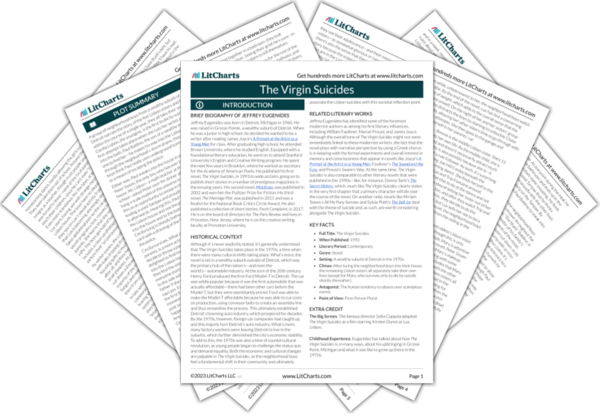Welcome to the LitCharts study guide on Jeffrey Eugenides's The Virgin Suicides. Created by the original team behind SparkNotes, LitCharts are the world's best literature guides.
The Virgin Suicides: Introduction
A concise biography of Jeffrey Eugenides plus historical and literary context for The Virgin Suicides.
The Virgin Suicides: Plot Summary
A quick-reference summary: The Virgin Suicides on a single page.
The Virgin Suicides: Detailed Summary & Analysis
In-depth summary and analysis of every chapter of The Virgin Suicides. Visual theme-tracking, too.
The Virgin Suicides: Themes
Explanations, analysis, and visualizations of The Virgin Suicides's themes.
The Virgin Suicides: Quotes
The Virgin Suicides's important quotes, sortable by theme, character, or chapter.
The Virgin Suicides: Characters
Description, analysis, and timelines for The Virgin Suicides's characters.
The Virgin Suicides: Terms
Description, analysis, and timelines for The Virgin Suicides's terms.
The Virgin Suicides: Symbols
Explanations of The Virgin Suicides's symbols, and tracking of where they appear.
The Virgin Suicides: Theme Wheel
An interactive data visualization of The Virgin Suicides's plot and themes.
Brief Biography of Jeffrey Eugenides
Jeffrey Eugenides was born in Detroit, Michigan in 1960. He was raised in Grosse Pointe, a wealthy suburb of Detroit. When he was a junior in high school, he decided he wanted to be a writer after reading James Joyce’s A Portrait of the Artist as a Young Man for class. After graduating high school, he attended Brown University, where he studied English. Equipped with a foundational literary education, he went on to attend Stanford University’s English and Creative Writing program. He spent the next few years in Brooklyn, where he worked as secretary for the Academy of American Poets. He published his first novel, The Virgin Suicides, in 1993 to wide acclaim, going on to publish short stories in a number of prestigious magazines in the ensuing years. His second novel, Middlesex, was published in 2002 and won him the Pulitzer Prize for Fiction. His third novel, The Marriage Plot, was published in 2011 and was a finalist for the National Book Critics Circle Award. He also published a collection of short stories, Fresh Complaint, in 2017. He is on the board of directors for The Paris Review and lives in Princeton, New Jersey, where he is on the creative writing faculty at Princeton University.
Get the entire The Virgin Suicides LitChart as a printable PDF.

Historical Context of The Virgin Suicides
Although it’s never explicitly stated, it’s generally understood that The Virgin Suicides takes place in the 1970s, a time when there were many cultural shifts taking place. What’s more, the novel is set in a wealthy suburb outside of Detroit, which was the primary hub of the nation’s—and even the world’s—automobile industry. At the turn of the 20th century, Henry Ford produced the first Ford Model-T in Detroit. The car was wildly popular because it was the first automobile that was actually affordable—there had been other cars before the Model-T, but they were exorbitantly priced. Ford was able to make the Model-T affordable because he was able to cut costs on production, using conveyor belts to create an assembly line and thus streamline the process. This ultimately established Detroit’s booming auto industry, which prospered for decades. By the 1970s, however, foreign car companies had caught up, and this majorly hurt Detroit’s auto industry. What’s more, many factory workers were leaving Detroit to live in the suburbs, which further diminished the city’s economic stability. To add to this, the 1970s was also a time of countercultural revolution, as young people began to challenge the status quo and demand equality. Both the economic and cultural changes are palpable in The Virgin Suicides, as the neighborhood boys feel a fundamental shift in their community and ultimately associate the Lisbon suicides with this societal inflection point.
Other Books Related to The Virgin Suicides
Jeffrey Eugenides has identified some of the foremost modernist authors as among his first literary influences, including William Faulkner, Marcel Proust, and James Joyce. Although the overall tone of The Virgin Suicides might not seem immediately linked to these modernist writers, the fact that the novel plays with narrative perspective by using a Greek chorus is in keeping with the formal experiments and overall interest in memory and consciousness that appear in novels like Joyce’s A Portrait of the Artist as a Young Man, Faulkner’s The Sound and the Fury, and Proust’s Swann’s Way. At the same time, The Virgin Suicides is also comparable to other literary novels that were published in the 1990s—like, for instance, Donna Tartt’s The Secret History, which, much like The Virgin Suicides, clearly states in the very first chapter that a primary character will die over the course of the novel. On another note, novels like Miriam Toews’s All My Puny Sorrows and Sylvia Plath’s The Bell Jar deal with the theme of suicide and, as such, are worth considering alongside The Virgin Suicides.
Key Facts about The Virgin Suicides
- Full Title: The Virgin Suicides
- When Published: 1993
- Literary Period: Contemporary
- Genre: Novel
- Setting: A wealthy suburb of Detroit in the 1970s
- Climax: After luring the neighborhood boys into their house, the remaining Lisbon sisters all separately take their own lives (except for Mary, who survives only to die by suicide shortly thereafter).
- Antagonist: The human tendency to obsess over scandalous events
- Point of View: First-Person Plural
Extra Credit for The Virgin Suicides
The Big Screen. The famous director Sofia Coppola adapted The Virgin Suicides as a film starring Kirsten Dunst as Lux Lisbon.
Childhood Experience. Eugenides has talked about how The Virgin Suicides is, in many ways, about his upbringing in Grosse Point, Michigan and what it was like to grow up there in the 1970s.












